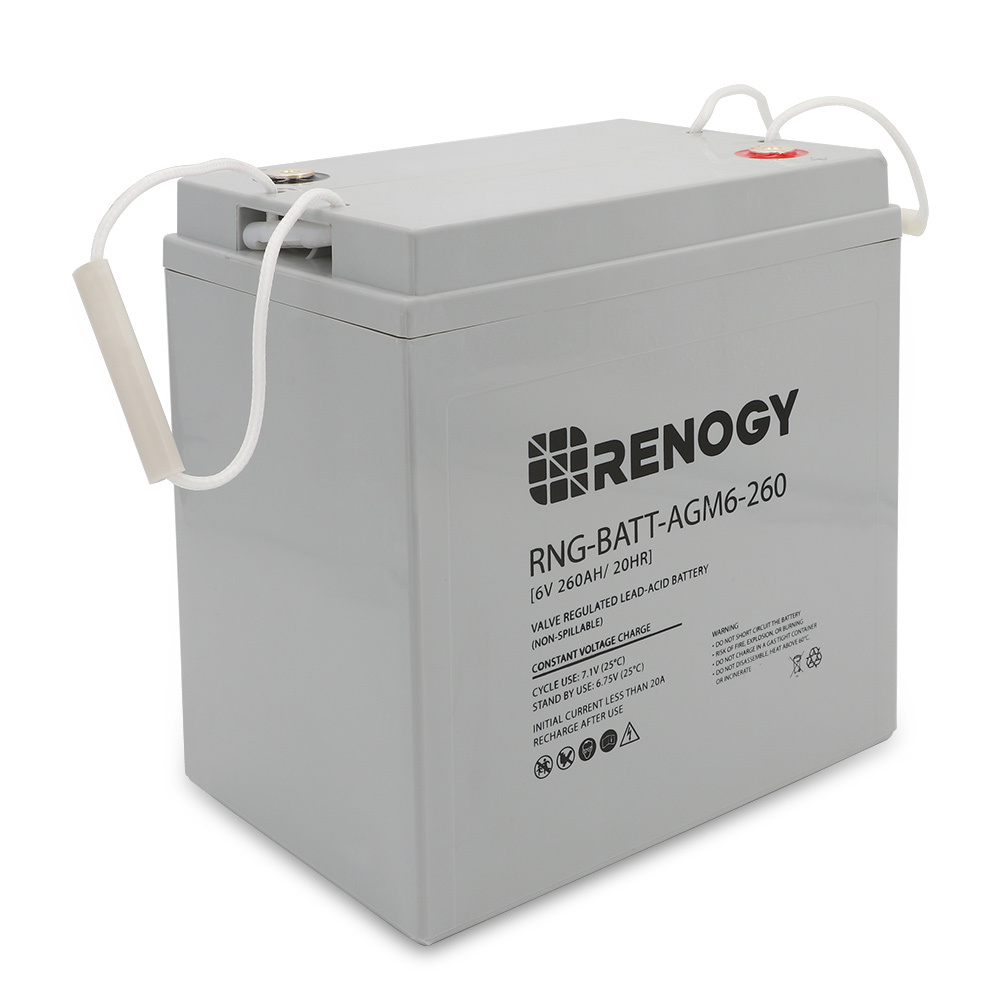How Does A 6 Volt Battery Work?
A 6 volt battery is a compact power source that provides electrical energy at a nominal voltage of 6 volts. These batteries play a crucial role in various solar energy applications, especially in small-scale and portable solar systems. Understanding how does a 6 volt battery work is essential for optimizing their use in solar power installations.

What is a 6 Volt Battery?
A 6-volt battery provides a nominal voltage of 6 volts, commonly used in smaller solar setups or as part of a larger battery bank. Their ability to store and provide a steady 6 volts of electrical power makes them an essential component in many solar applications.
Components of 6 volt battery
A typical 6-volt battery consists of the following components.
- Electrochemical Cells
The core of a 6-volt battery is its electrochemical cells. Each cell generates a certain amount of voltage through a chemical reaction. For a 6-volt battery, it usually contains three 2-volt cells connected in series. - Electrolyte
The electrolyte is a chemical solution inside the battery that facilitates the flow of ions between the battery's positive and negative terminals. This flow of ions is essential for generating electrical energy. - Plates
The battery contains positive and negative plates submerged in the electrolyte. These plates are made from materials like lead (in lead-acid batteries) or other conductive materials that participate in the chemical reaction to produce electricity. - Separator
The separator is a non-conductive material that keeps the positive and negative plates apart, preventing short circuits and ensuring efficient energy production. - Terminals
The terminals are the points where the battery connects to electrical circuits. They provide the pathway for current to flow from the battery to the device being powered.
How Does a 6 Volt Battery Work?
The operation of a 6-volt battery involves several key processes:
Chemical Reaction: When the battery is in use, a chemical reaction occurs between the electrolyte and the plates. In a lead-acid battery, for instance, sulfuric acid reacts with the lead plates to produce lead sulfate, water, and electrical energy.
Ion Flow: The chemical reaction generates ions that move between the positive and negative plates through the electrolyte. This movement of ions creates an electric current.
Voltage Generation: The cumulative voltage of the individual cells in the battery adds up to the total output voltage. In a 6-volt battery, three 2-volt cells are connected in series, resulting in a total voltage of 6 volts.
Power Delivery: The generated electric current flows through the battery terminals and into the connected device. The battery supplies the device with a stable 6-volt power source, allowing it to operate effectively.
Pros and Cons of 6 volt battery
A 6-volt battery is a practical and cost-effective choice for many devices, including solar systems and small electronics. It's compact, durable, and affordable. However, it might not provide enough power for larger applications and requires regular maintenance to ensure peak performance.
Pros
Affordable: Generally less expensive than higher-voltage batteries, making them a cost-effective option for many applications.
Compact Size: Suitable for smaller devices and systems due to its compact design.
Durable: Known for robustness and ability to handle multiple charge-discharge cycles.
Flexibility: Can be used in various configurations, either individually or as part of a larger battery bank.
Ease of Integration: Compatible with many small-scale solar systems and low-voltage devices.
Cons
Limited Capacity: May not provide sufficient power for high-demand applications or larger systems.
Lower Efficiency: Can be less efficient in terms of energy storage and delivery compared to higher-voltage batteries.
Voltage Limitations: May require multiple batteries or complex configurations to meet specific voltage and capacity needs in more demanding applications.
How to connect 6 volt batteries?
There are two main ways to wire batteries: in series and in parallel.
In series
Connecting batteries in series adds the voltage of the two batteries, but it keeps the same amp hours. To connect batteries in a series, connect the negative terminal of the first battery to the positive terminal of the second battery. Use another set of cables to connect the open positive and negative terminals to your application.
You can connect two 6 volt batteries in series so that they can put out 12 volts of power. However, when you use batteries hooked up in series, it will only charge to the capacity of the battery with the lowest amp hour capacity.
In parallel
Connecting batteries in parallel will increase your current rating, but the voltage will stay the same. To join batteries in parallel, connect both the positive terminals and another jumper wire to connect both the negative terminals of both batteries to each other. Negative to negative and positive to positive.
When two 6 volt batteries are connected in parallel, their combined voltage will still be 6 vols but their amp hour capacity will be equal to the sum of the capacity of the batteries.
Maintenance Tips for 6 Volt Batteries
To ensure the longevity and performance of your 6-volt battery, consider the following maintenance tips.
- Regular Charging: Keep the battery charged according to the manufacturer's recommendations to avoid deep discharges that can damage the battery.
- Clean Terminals: Ensure that the battery terminals are clean and free from corrosion to maintain good electrical contact.
- Proper Storage: Store the battery in a cool, dry place to prevent damage from extreme temperatures or moisture.
6 Volt battery vs 12 Volt battery
Beyond the obvious voltage difference between 6 and 12 volt batteries, there are also a few other things that set them apart. When weight and cost are not important factors, and higher power is needed, you should go with 12 volt batteries instead of the 6 volt option.
6 volt batteries use heavier plates in each cell and typically have longer lifespans than 12 volt batteries. They can last anywhere from four to eight years, depending on maintenance, type, and use of the battery. Additionally, 6 volt batteries weigh less than 12 volt batteries, making them much easier to handle and move.
Conclusion
6 volt battery can be used in a variety of applications and can be connected in series to power 12, 24, and 48 volt systems. The main advantage of using 6 volt deep cycle batteries instead of 12 volt batteries is to achieve increased amp hours to power your RV, van, or camper.
FAQ
Can you use a 6 volt battery with a 12 volt solar panel?
Not on its own. When you want to charge a 12 volt panel, you’ll want at least a 12 volt battery bank. So you can still use 6 volt batteries to charge that panel, but you’ll need at least two batteries that are connected in series.
Can you use a 12v solar charger on a 6v battery?
Again if you have two 6 volt batteries connected in series, you can use a 12 volt battery charger. However, we do not recommend using a 12 volt battery charger if you only have one 6 volt battery.
Can I produce a 24v or 48v system with 6 volt batteries?
Yes, as long as you’re wiring your 6 volt batteries in series, they’ll add up to the desired voltage. However, if you need a larger 48 volt system, it would probably be wise to purchase larger voltage batteries to save weight and space.











